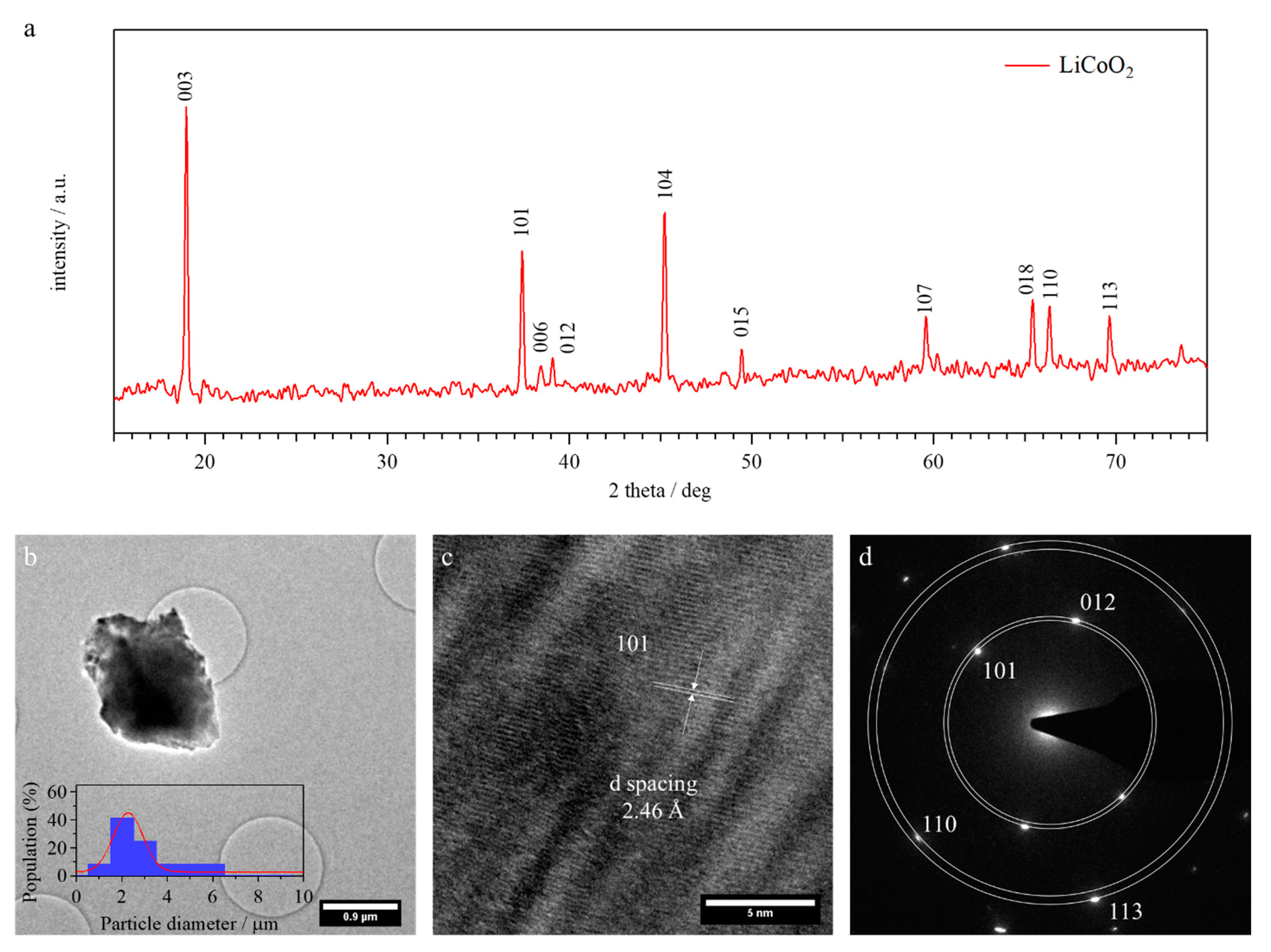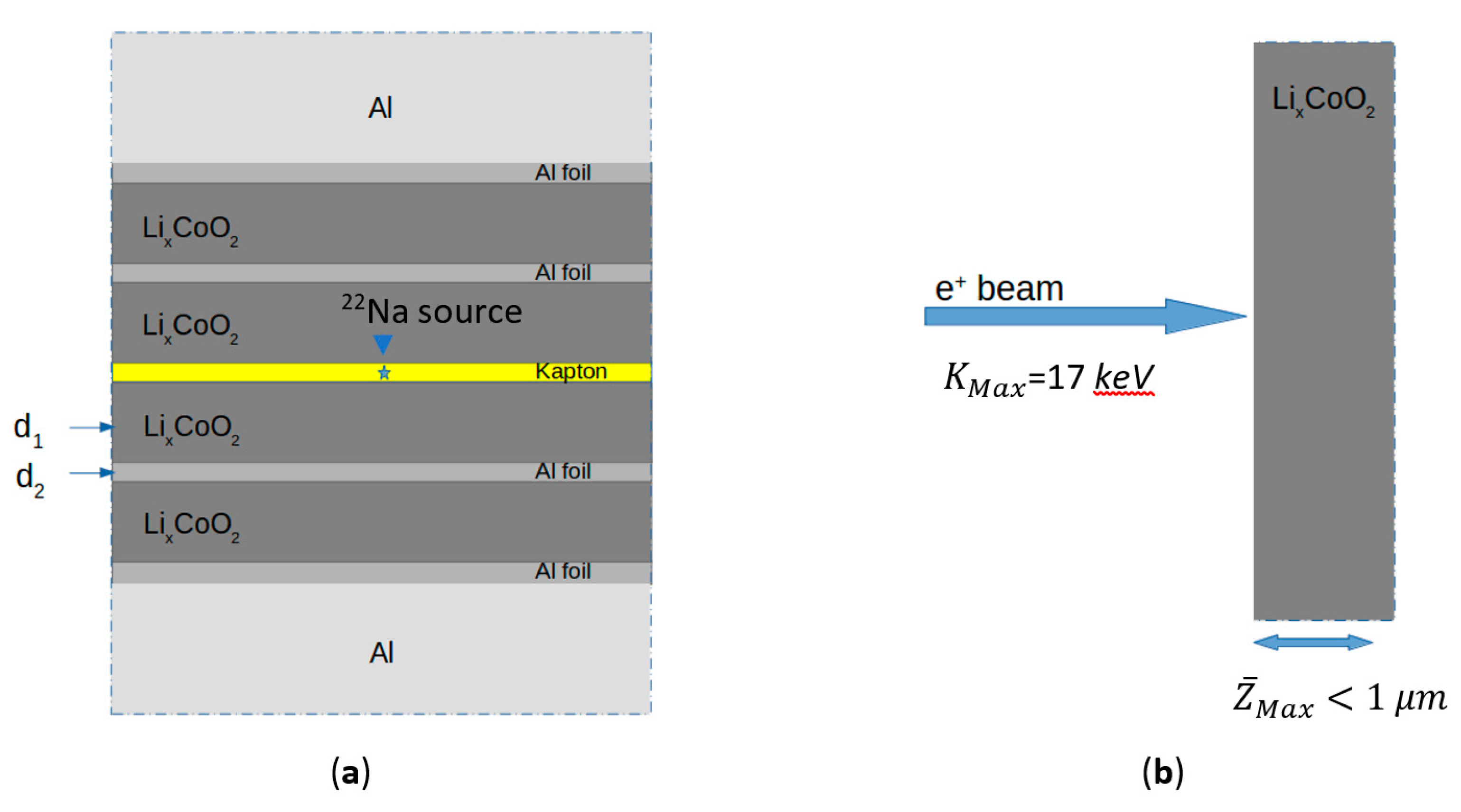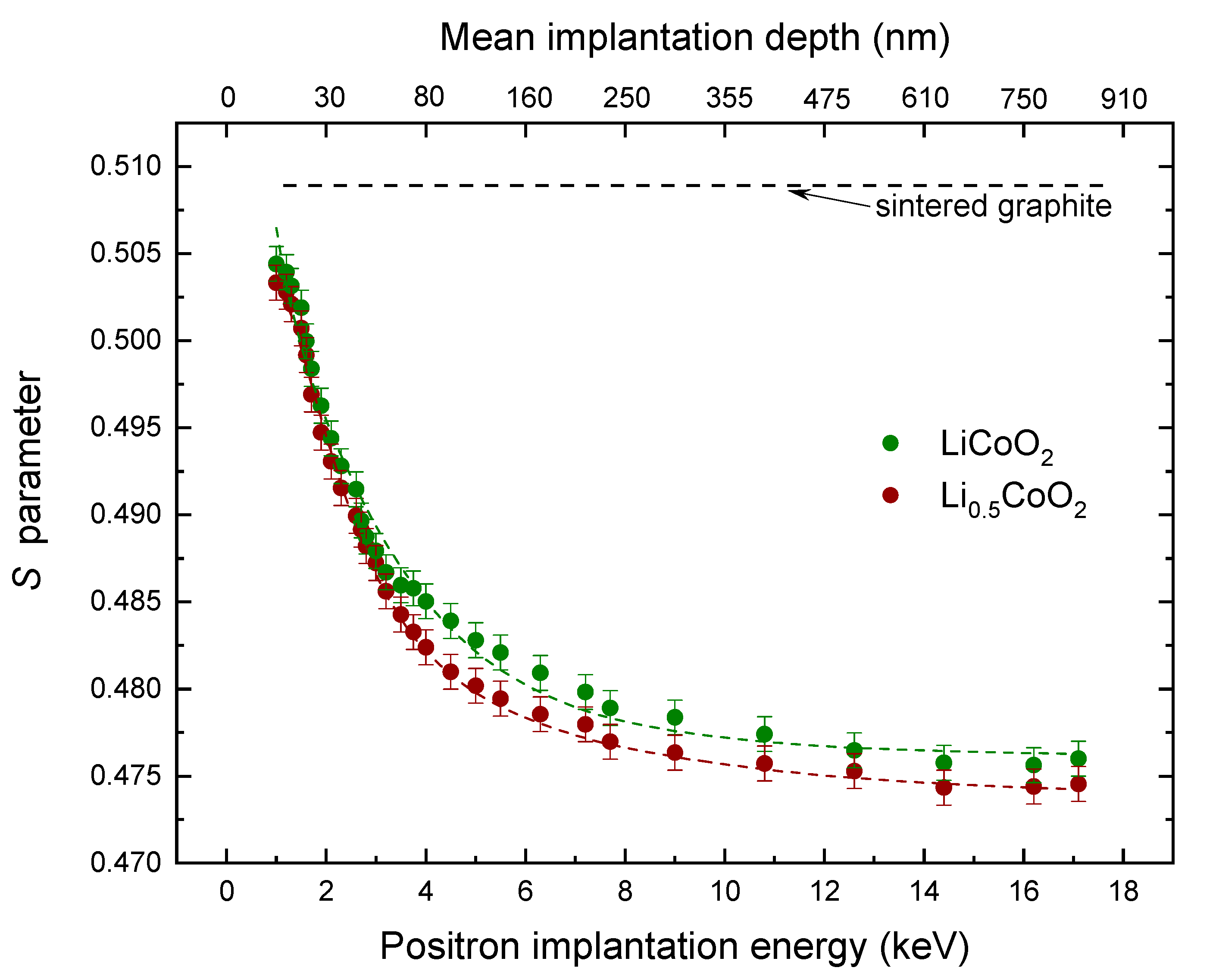Positron Annihilation Spectroscopy as a Diagnostic Tool for the Study of LiCoO2 Cathode of Lithium-Ion Batteries
Abstract
:1. Introduction
2. Results and Discussion
2.1. Structure and Morphology
2.2. Positron Annihilation Lifetime Spectroscopy
2.2.1. Reference Samples
2.2.2. Cathode Samples
2.3. Doppler Broadening
3. Materials and Methods
4. Conclusions
Author Contributions
Funding
Institutional Review Board Statement
Informed Consent Statement
Data Availability Statement
Acknowledgments
Conflicts of Interest
Appendix A

References
- Pang, Q.; Kwok, C.Y.; Kundu, D.; Liang, X.; Nazar, L.F. Lightweight Metallic MgB2 Mediates Polysulfide Redox and Promises High-Energy-Density Lithium-Sulfur Batteries. Joule 2019, 3, 136–148. [Google Scholar] [CrossRef] [Green Version]
- Müller, V.; Bernhard, R.; Wegener, J.; Pfeiffer, J.; Rössler, S.; Scurtu, R.G.; Memm, M.; Danzer, M.A.; Wohlfahrt-Mehrens, M. Evaluation of Scalable Porous Si-Rich Si/C Composites with Low Volume Expansion in Coin Cells to Prismatic Cell Formats. Energy Technol. 2020, 8, 202000217. [Google Scholar] [CrossRef]
- Casino, S.; Niehoff, P.; Börner, M.; Winter, M. Protective coatings on silicon particles and their effect on energy density and specific energy in lithium ion battery cells: A model study. J. Energy Storage 2020, 29, 101376. [Google Scholar] [CrossRef]
- Okashy, S.; Luski, S.; Elias, Y.; Aurbach, D. Practical anodes for Li-ion batteries comprising metallurgical silicon particles and multiwall carbon nanotubes. J. Solid State Electrochem. 2018, 22, 3289–3301. [Google Scholar] [CrossRef]
- Langdon, J.; Manthiram, A. Crossover Effects in Batteries with High-Nickel Cathodes and Lithium-Metal Anodes. Adv. Funct. Mater. 2021, 31, 2010267. [Google Scholar] [CrossRef]
- Nanda, S.; Gupta, A.; Manthiram, A. Anode-Free Full Cells: A Pathway to High-Energy Density Lithium-Metal Batteries. Adv. Energy Mater. 2021, 11, 202000804. [Google Scholar] [CrossRef]
- Pagot, G.; Bertasi, F.; Vezzù, K.; Nawn, G.; Pace, G.; Nale, A.; Di Noto, V. Correlation between Properties and Conductivity Mechanism in Poly(vinyl alcohol)-based Lithium Solid Electrolytes. Solid State Ion. 2018, 320, 177–185. [Google Scholar] [CrossRef]
- Osada, I.; De Vries, H.; Scrosati, B.; Passerini, S. Ionic-Liquid-Based Polymer Electrolytes for Battery Applications. Angew. Chem. Int. Ed. 2016, 55, 500–513. [Google Scholar] [CrossRef] [PubMed]
- Bertasi, F.; Pagot, G.; Vezzù, K.; Nale, A.; Pace, G.; Herve Bang, Y.; Crivellaro, G.; Negro, E.; Di Noto, V. Lithiated Nanoparticles Doped with Ionic Liquids as Quasi-Solid Electrolytes for Lithium Batteries. Electrochim. Acta 2019, 307, 51–63. [Google Scholar] [CrossRef]
- Bertasi, F.; Pagot, G.; Vezzù, K.; Negro, E.; Sideris, P.J.; Greenbaum, S.G.; Ohno, H.; Scrosati, B.; Di Noto, V. Exotic solid state ion conductor from fluorinated titanium oxide and molten metallic lithium. J. Power Sources 2018, 400, 16–22. [Google Scholar] [CrossRef]
- Zewde, B.W.; Elia, G.A.; Admassie, S.; Zimmermann, J.; Hagemann, M.; Isfort, C.S.; Scrosati, B.; Hassoun, J. Polyethylene oxide electrolyte added by silane-functionalized TiO2 filler for lithium battery. Solid State Ion. 2014, 268, 174–178. [Google Scholar] [CrossRef]
- Bertasi, F.; Negro, E.; Vezzù, K.; Nawn, G.; Pagot, G.; Di Noto, V. Single-Ion-Conducting Nanocomposite Polymer Electrolytes for Lithium Batteries Based on Lithiated-Fluorinated-Iron Oxide and Poly(ethylene glycol) 400. Electrochim. Acta 2015, 175, 113–123. [Google Scholar] [CrossRef]
- Qiao, L.; Oteo, U.; Zhang, Y.; Peña, S.R.; Martínez-Ibañez, M.; Santiago, A.; Cid, R.; Meabe, L.; Manzano, H.; Carrasco, J.; et al. Trifluoromethyl-free anion for highly stable lithium metal polymer batteries. Energy Storage Mater. 2020, 32, 225–233. [Google Scholar] [CrossRef]
- Stettner, T.; Lingua, G.; Falco, M.; Balducci, A.; Gerbaldi, C. Protic Ionic Liquids-Based Crosslinked Polymer Electrolytes: A New Class of Solid Electrolytes for Energy Storage Devices. Energy Technol. 2020, 8, 2000742. [Google Scholar] [CrossRef]
- Martinez-Ibañez, M.; Sanchez-Diez, E.; Qiao, L.; Zhang, Y.; Judez, X.; Santiago, A.; Aldalur, I.; Carrasco, J.; Zhu, H.; Forsyth, M.; et al. Unprecedented Improvement of Single Li-Ion Conductive Solid Polymer Electrolyte Through Salt Additive. Adv. Funct. Mater. 2020, 30, 2000455. [Google Scholar] [CrossRef]
- Colombo, F.; Bonizzoni, S.; Ferrara, C.; Simonutti, R.; Mauri, M.; Falco, M.; Gerbaldi, C.; Mustarelli, P.; Ruffo, R. Polymer-in-Ceramic Nanocomposite Solid Electrolyte for Lithium Metal Batteries Encompassing PEO-Grafted TiO2 Nanocrystals. J. Electrochem. Soc. 2020, 167, 070535. [Google Scholar] [CrossRef] [Green Version]
- Zeng, X.; Zhan, C.; Lu, J.; Amine, K. Stabilization of a High-Capacity and High-Power Nickel-Based Cathode for Li-Ion Batteries. Chem 2018, 4, 690–704. [Google Scholar] [CrossRef] [Green Version]
- Cui, Z.; Xie, Q.; Manthiram, A. Zinc-Doped High-Nickel, Low-Cobalt Layered Oxide Cathodes for High-Energy-Density Lithium-Ion Batteries. ACS Appl. Mater. Interfaces 2021, 13, 15324–15332. [Google Scholar] [CrossRef]
- Pagot, G.; Bandiera, M.; Vezzù, K.; Migliori, A.; Bertoncello, R.; Negro, E.; Morandi, V.; Di Noto, V. High valence transition metal-doped olivine cathodes for superior energy and fast cycling lithium batteries. J. Mater. Chem. A 2020, 8, 25727–25738. [Google Scholar] [CrossRef]
- Pagot, G.; Bertasi, F.; Nawn, G.; Negro, E.; Bach Delpeuch, A.; Vezzù, K.; Cristofori, D.; Di Noto, V. Effect of Graphite and Copper Oxide on the Performance of High Potential Li[Fe1/3Ni1/3Co1/3]PO4 Olivine Cathodes for Lithium Batteries. Electrochim. Acta 2017, 225, 533–542. [Google Scholar] [CrossRef]
- Schmiegel, J.P.; Qi, X.; Klein, S.; Winkler, V.; Evertz, M.; Nölle, R.; Henschel, J.; Reiter, J.; Terborg, L.; Fan, Q.; et al. Improving the cycling performance of high-voltage NMC111 || graphite lithium ion cells by an effective urea-based electrolyte additive. J. Electrochem. Soc. 2019, 166, A2910–A2920. [Google Scholar] [CrossRef]
- Helbig, J.; Beuse, T.; Siozios, V.; Placke, T.; Winter, M.; Schmuch, R. Finding the sweet spot: Li/Mn-rich cathode materials with fine-tuned core–shell particle design for high-energy lithium ion batteries. Electrochim. Acta 2021, 366, 137413. [Google Scholar] [CrossRef]
- Pagot, G.; Bertasi, F.; Nawn, G.; Negro, E.; Carraro, G.; Barreca, D.; Maccato, C.; Polizzi, S.; Di Noto, V. High-Performance Olivine for Lithium Batteries: Effects of Ni/Co Doping on the Properties of LiFeαNiβCoγPO4 Cathodes. Adv. Funct. Mater. 2015, 25, 4032–4037. [Google Scholar] [CrossRef]
- Yang, S.; Zhou, S.; Hua, Y.; Zhou, X.; Liu, X.; Pan, Y.; Ling, H.; Wu, B. A parameter adaptive method for state of charge estimation of lithium-ion batteries with an improved extended Kalman filter. Sci. Rep. 2021, 11, 1–15. [Google Scholar] [CrossRef]
- Chen, J.; Feng, X.; Jiang, L.; Zhu, Q. State of charge estimation of lithium-ion battery using denoising autoencoder and gated recurrent unit recurrent neural network. Energy 2021, 227, 120451. [Google Scholar] [CrossRef]
- Sihvo, J.; Roinila, T.; Stroe, D.I. Novel Fitting Algorithm for Parametrization of Equivalent Circuit Model of Li-Ion Battery from Broadband Impedance Measurements. IEEE Trans. Ind. Electron. 2021, 68, 4916–4926. [Google Scholar] [CrossRef]
- Ma, L.; Hu, C.; Cheng, F. State of Charge and State of Energy Estimation for Lithium-Ion Batteries Based on a Long Short-Term Memory Neural Network. J. Energy Storage 2021, 37, 102440. [Google Scholar] [CrossRef]
- Dupasquier, A.; Ferragut, R.; Iglesias, M.M.; Massazza, M.; Riontino, G.; Mengucci, P.; Barucca, G.; Macchi, C.E.; Somoza, A. Hardening nanostructures in an AlZnMg alloy. Philos. Mag. 2007, 87, 3297–3323. [Google Scholar] [CrossRef] [Green Version]
- Gidley, D.W.; Peng, H.-G.; Vallery, R.S. Positron Annihilation As A Method To Characterize Porous Materials. Annu. Rev. Mater. Res. 2006, 36, 49–79. [Google Scholar] [CrossRef] [Green Version]
- Puska, M.J.; Nieminen, R.M. Theory of positrons in solids and on solid surfaces. Rev. Mod. Phys. 1994, 66, 841–897. [Google Scholar] [CrossRef] [Green Version]
- Tuomisto, F.; Makkonen, I. Defect identification in semiconductors with positron annihilation: Experiment and theory. Rev. Mod. Phys. 2013, 85, 1583–1631. [Google Scholar] [CrossRef] [Green Version]
- Schultz, P.J.; Lynn, K.G. Interaction of positron beams with surfaces, thin films, and interfaces. Rev. Mod. Phys. 1988, 60, 701–779. [Google Scholar] [CrossRef]
- Canesi, E.V.; Binda, M.; Abate, A.; Guarnera, S.; Moretti, L.; D’Innocenzo, V.; Sai Santosh Kumar, R.; Bertarelli, C.; Abrusci, A.; Snaith, H.; et al. The effect of selective interactions at the interface of polymer–oxide hybrid solar cells. Energy Environ. Sci. 2012, 5, 9068–9076. [Google Scholar] [CrossRef]
- Barbiellini, B.; Kuriplach, J. Advanced characterization of lithium battery materials with positrons. J. Phys. Conf. Ser. 2017, 791, 012016. [Google Scholar] [CrossRef] [Green Version]
- Klinser, G.; Kren, H.; Koller, S.; Würschum, R. Operando monitoring of charging-induced defect formation in battery electrodes by positrons. Appl. Phys. Lett. 2019, 114, 013905. [Google Scholar] [CrossRef]
- Klinser, G.; Topolovec, S.; Kren, H.; Koller, S.; Krenn, H.; Würschum, R. Charging of lithium cobalt oxide battery cathodes studied by means of magnetometry. Solid State Ion. 2016, 293, 64–71. [Google Scholar] [CrossRef]
- Parz, P.; Fuchsbichler, B.; Koller, S.; Bitschnau, B.; Mautner, F.-A.; Puff, W.; Würschum, R. Charging-induced defect formation in LixCoO2 battery cathodes studied by positron annihilation spectroscopy. Appl. Phys. Lett. 2013, 102, 151901. [Google Scholar] [CrossRef]
- Würschum, R.; Topolovec, S.; Klinser, G.; Sprengel, W.; Kren, H.; Koller, S.; Krenn, H.; Hugenschmidt, C.; Reiner, M.; Gigl, T.; et al. Defects and Charging Processes in Li-Ion Battery Cathodes Studied by Operando Magnetometry and Positron Annihilation. Mater. Sci. Forum 2017, 879, 2125–2130. [Google Scholar] [CrossRef]
- Kuriplach, J.; Barbiellini, B. Parameter-Free Gradient Correction for Positron States in Oxides. Defect Diffus. Forum 2017, 373, 35–40. [Google Scholar] [CrossRef]
- Lin, Q.; Li, Q.a.; Gray, K.E.; Mitchell, J.F. Vapor Growth and Chemical Delithiation of Stoichiometric LiCoO2 Crystals. Cryst. Growth Des. 2012, 12, 1232–1238. [Google Scholar] [CrossRef]
- Calloni, A.; Dupasquier, A.; Ferragut, R.; Folegati, P.; Iglesias, M.M.; Makkonen, I.; Puska, M.J. Positron localization effects on the Doppler broadening of the annihilation line: Aluminum as a case study. Phys. Rev. B 2005, 72, 054112. [Google Scholar] [CrossRef] [Green Version]
- Brandt, W. Positron dynamics in solids. Appl. Phys. 1974, 5, 1–23. [Google Scholar] [CrossRef]
- Barbiellini, B.; Suzuki, K.; Orikasa, Y.; Kaprzyk, S.; Itou, M.; Yamamoto, K.; Wang, Y.J.; Hafiz, H.; Yamada, R.; Uchimoto, Y.; et al. Identifying a descriptor for d-orbital delocalization in cathodes of Li batteries based on x-ray Compton scattering. Appl. Phys. Lett. 2016, 109, 073102. [Google Scholar] [CrossRef] [Green Version]
- Cartier, E.; Heinrich, F.; Pfluger, P.; Güntherodt, H.J. Positron Annihilation in Graphite Intercalation Compounds. Phys. Rev. Lett. 1981, 46, 272–275. [Google Scholar] [CrossRef]
- Veen, A.V.; Schut, H.; Vries, J.D.; Hakvoort, R.A.; Ijpma, M.R. Analysis of positron profiling data by means of “VEPFIT”. AIP Conf. Proc. 1991, 218, 171–198. [Google Scholar] [CrossRef]
- Consolati, G.; Ferragut, R.; Galarneau, A.; Di Renzo, F.; Quasso, F. Mesoporous materials for antihydrogen production. Chem. Soc. Rev. 2013, 42, 3821–3832. [Google Scholar] [CrossRef]
- Kansy, J. Microcomputer program for analysis of positron annihilation lifetime spectra. Nucl. Instrum. Methods Phys. Res. Sect. A Accel. Spectrometers Detect. Assoc. Equip. 1996, 374, 235–244. [Google Scholar] [CrossRef]
- Panzarasa, G.; Aghion, S.; Soliveri, G.; Consolati, G.; Ferragut, R. Positron annihilation spectroscopy: A new frontier for understanding nanoparticle-loaded polymer brushes. Nanotechnology 2015, 27, 02LT03. [Google Scholar] [CrossRef] [PubMed]
- Shi, W.; Callewaert, V.; Barbiellini, B.; Saniz, R.; Butterling, M.; Egger, W.; Dickmann, M.; Hugenschmidt, C.; Shakeri, B.; Meulenberg, R.W.; et al. Nature of the Positron State in CdSe Quantum Dots. Phys. Rev. Lett. 2018, 121, 057401. [Google Scholar] [CrossRef] [Green Version]
- Suzuki, K.; Suzuki, S.; Otsuka, Y.; Tsuji, N.; Jalkanen, K.; Koskinen, J.; Hoshi, K.; Honkanen, A.-P.; Hafiz, H.; Sakurai, Y.; et al. Redox oscillations in 18650-type lithium-ion cell revealed by in operando Compton scattering imaging. Appl. Phys. Lett. 2021, 118, 161902. [Google Scholar] [CrossRef]
- Dryzek, J.; Czapla, A.; Kusior, E. Positron annihilation studies of the multilayer system. J. Phys. Condens. Matter 1998, 10, 10827–10838. [Google Scholar] [CrossRef]



| References | τ1 (ps) | τ2 (ps) | I1 (%) | I2 (%) | τbulk (ps) | τav (ps) |
|---|---|---|---|---|---|---|
| Al foil (rolled) | 60 (5) | 228 (3) | 15 (2) | 85 (2) | 162 (4) | 208 (3) |
| Al (polycrystallyne) | 158 (1) | 234 (3) | 96 (1) | 4 (2) | 161 (2) | 162 (2) |
| Graphite (C) | 107 (4) | 400 (5) | 13 (3) | 87 (2) | - | 362 (5) |
| Cathode | Thickness (μm) | τ1 (ps) | τ2 (ps) | I1 (%) | I2 (%) | τav (ps) |
|---|---|---|---|---|---|---|
| LiCoO2 | 59 (2) | 163 (2) | 315 (3) | 66 (2) | 34 (2) | 215 (4) |
| Li0.5CoO2 | 67 (2) | 181 (2) | 327 (3) | 73 (2) | 27 (2) | 220 (4) |
| Cathode | L+ (nm) | Ssurface | Sbulk |
|---|---|---|---|
| LiCoO2 | 60 (3) | 0.506 (1) | 0.4760 (7) |
| Li0.5CoO2 | 55 (3) | 0.505 (1) | 0.4742 (7) |
Publisher’s Note: MDPI stays neutral with regard to jurisdictional claims in published maps and institutional affiliations. |
© 2021 by the authors. Licensee MDPI, Basel, Switzerland. This article is an open access article distributed under the terms and conditions of the Creative Commons Attribution (CC BY) license (https://creativecommons.org/licenses/by/4.0/).
Share and Cite
Pagot, G.; Toso, V.; Barbiellini, B.; Ferragut, R.; Di Noto, V. Positron Annihilation Spectroscopy as a Diagnostic Tool for the Study of LiCoO2 Cathode of Lithium-Ion Batteries. Condens. Matter 2021, 6, 28. https://doi.org/10.3390/condmat6030028
Pagot G, Toso V, Barbiellini B, Ferragut R, Di Noto V. Positron Annihilation Spectroscopy as a Diagnostic Tool for the Study of LiCoO2 Cathode of Lithium-Ion Batteries. Condensed Matter. 2021; 6(3):28. https://doi.org/10.3390/condmat6030028
Chicago/Turabian StylePagot, Gioele, Valerio Toso, Bernardo Barbiellini, Rafael Ferragut, and Vito Di Noto. 2021. "Positron Annihilation Spectroscopy as a Diagnostic Tool for the Study of LiCoO2 Cathode of Lithium-Ion Batteries" Condensed Matter 6, no. 3: 28. https://doi.org/10.3390/condmat6030028
APA StylePagot, G., Toso, V., Barbiellini, B., Ferragut, R., & Di Noto, V. (2021). Positron Annihilation Spectroscopy as a Diagnostic Tool for the Study of LiCoO2 Cathode of Lithium-Ion Batteries. Condensed Matter, 6(3), 28. https://doi.org/10.3390/condmat6030028









